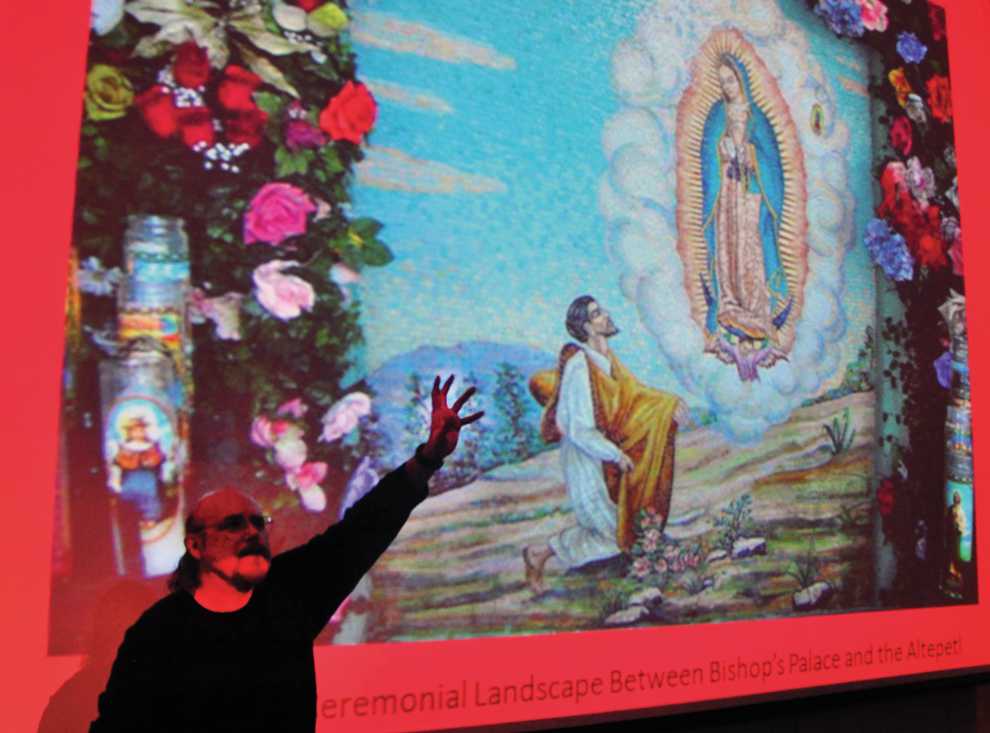
Harvard professor Dr. David Carrasco used stories of self-discovery, ancient Meso-American cultures, and research by various historians to connect and emphasize the importance of religion and current immigration issues.
“Carrasco spoke at Borderlands and Immigration The Power of Religious Symbols and the Politics of Resistanc” on Wednesday.
“My Aztec moment happen when I was 13-years-old when I went to Mexico City,” Carrasco said.
It was while visiting a museum in the zocalo, the city square, that Carrasco first saw Aztec calendars, goddesses and writing, and realized he was Meztizo, a person of mixed race, and this was part of his ancestry.
“I walked around this place like I was having a break down,” Carrasco said. “I was raised in this country (United States) and told to be ashamed of these places.
“I was taught that Mexico was good for folklore, but if you want deep stuff don’t look here,” Carrasco said. “More than pride, I felt a tremendous amount of curiosity. If I wanted to study the Americas I needed to study this.”
A few years ago Carrasco and a team of 20 scholars had a rare opportunity to study Mapa de Cuauhtinchan, a manuscript of the ancient story of immigration that was once believed to be lost.
While many of the challenges of being an immigrant are displayed on the map, it also displayed a Catholic church next to an indigenous temple. This is something that could not have existed in the 1540s, some 20 years after Spaniards had come to conquer Mexico, according to Carrasco.
He said this shows that while many Mexicans had been converted and accepted Catholicism, they were saying, we have two sacred traditions and we will not forget either.
“Some see religions as a superficial thing, that politics and economics shape the world,” Carrasco said. “I want to help bring religion back into the nucleus of understanding society, we can’t separate it from politics and economics to understand society.”
An upside-down map of North America was displayed during the lecture, not to confuse the audience, but to show that the chronology of America is not one of east to west, as he was told growing up, but rather one from all directions.
Carrasco shared the story of La Virgen de Guadalupe. In it, a man is asked by the Virgin de Guadalupe to request a chapel be built by a bishop where they were at. After the bishop refuses twice, the Virgin gives the man roses, which never grow in this territory because of the freezing cold weather. When the man returns to the bishop a third time he is beaten and petals fall from his garment. When he unveils his tilma, an image of the Virgen de Guadalupe is imprinted on him.
Images of the Virgen de Guadalupe can now be seen around the world, including images largely painted around buildings in Chicago and Wisconsin, that Carrasco displayed.
Carrasco said a 20th century study by John Coatsworth, dean at Columbia University, investigated how often the U.S. was a part of regime change in Latin American countries. The study found they were involved once every 18 months, 42 times. Carrasco remarked that maybe Hispanics come to the Unites States because we go to their countries so often.
Carrasco quoted “Playing in the Darkness,” a book by Toni Morrison, one of his colleagues at Harvard University, that discusses the task of remapping the Americas.
“(My goal is to) put forth an argument for extending the study of American literature. I want to draw a map, so to speak, of a critical geography and use that map to open as much space for discovery, intellectual adventure, and close exploration as did the original charting of the New World – without the mandate for conquest,” Carrasco quoted Morrison.
“I want to show that a new demography can lead to a new democracy,” Carrasco said.
The event was first organized by CSUN professor of religious studies Dr. Rick Talbott. It was sponsored by CSUNs religious, Chicana/o studies, and graduate studies departments as well as UCLAs Center for the Study of Religion.
“Carrasco is one of my intellectual heroes,” Talbott said.




